Gift Cards
Project: BBY Gift Card Program
Role: Art Director & Designer, Brand Design & Integration team
Client: Best Buy Co.
Key Skills: Photoshop, Illustrator, Brand Identity, Product Design
Summary: An ongoing program of various gift card assortments. Each card targeted either a specific drive time, holiday, season, or consumer demographic. For each card, I began at the concept stage, finished at the press check, and everything in between.
Below is a gallery of assorted Gift Cards from my time with Best Buy. Photography of the final, printed product is shown where available.
Click any image to enlarge detail.

This is a trifold gift card that was produced to appeal to younger, edgier folks than the typical “vanilla” (slightly generic) cards otherwise available. Had to fight a bit to get approval for the skulls appearing on the game controller; the original concepts had heaps more, and my brainstorming files filled with similar odd/twisted cute-but-disturbing entries.
This card features UV spot gloss and spot thermographic (raised) texture for the white areas. My role spanned from the original concept sketch to illustrator, final mechanical production, and press check.

The open value, or “generic”, gift card is (or rather was at the time; I have no current data for comparison) Best Buy’s number one SKU; meaning it alone accounts for more revenue per year than any other single item they sell, exceeding a billion dollars annually. This makes it incredibly valuable as a brand vehicle—not just a product, and by far the most visible, high-dollar design I’ve ever created.
Some background on the project: at the time of its redesign, the company had been using a couple of flashy, and frankly gimmicky/gaudy designs that relied on cheap lenticular or hologram effects to gain attention. I understand the time and place for these things, but at a time when the company was looking to elevate their brand design, public image, and sophistication, such gimmicks are toys better left behind in childhood.
As such, a streamlined, elegant approach that put the brand name, marks and elements first. Solid on-brand blue, simple typography, and the use of subtle textures and contrast between shiny vs matte to do the talking. The card is a color-matched solid core plastic with a spot silver foil, and the giant logo on the carrier is a UV spot matte that exhibits different effects at varying viewing angles.
This design changed very little from my first concept presentation, and was received well both internally and publicly. I served as the Art Director, Designer, and Production Artist for this project, and assisted with on-site press checks.
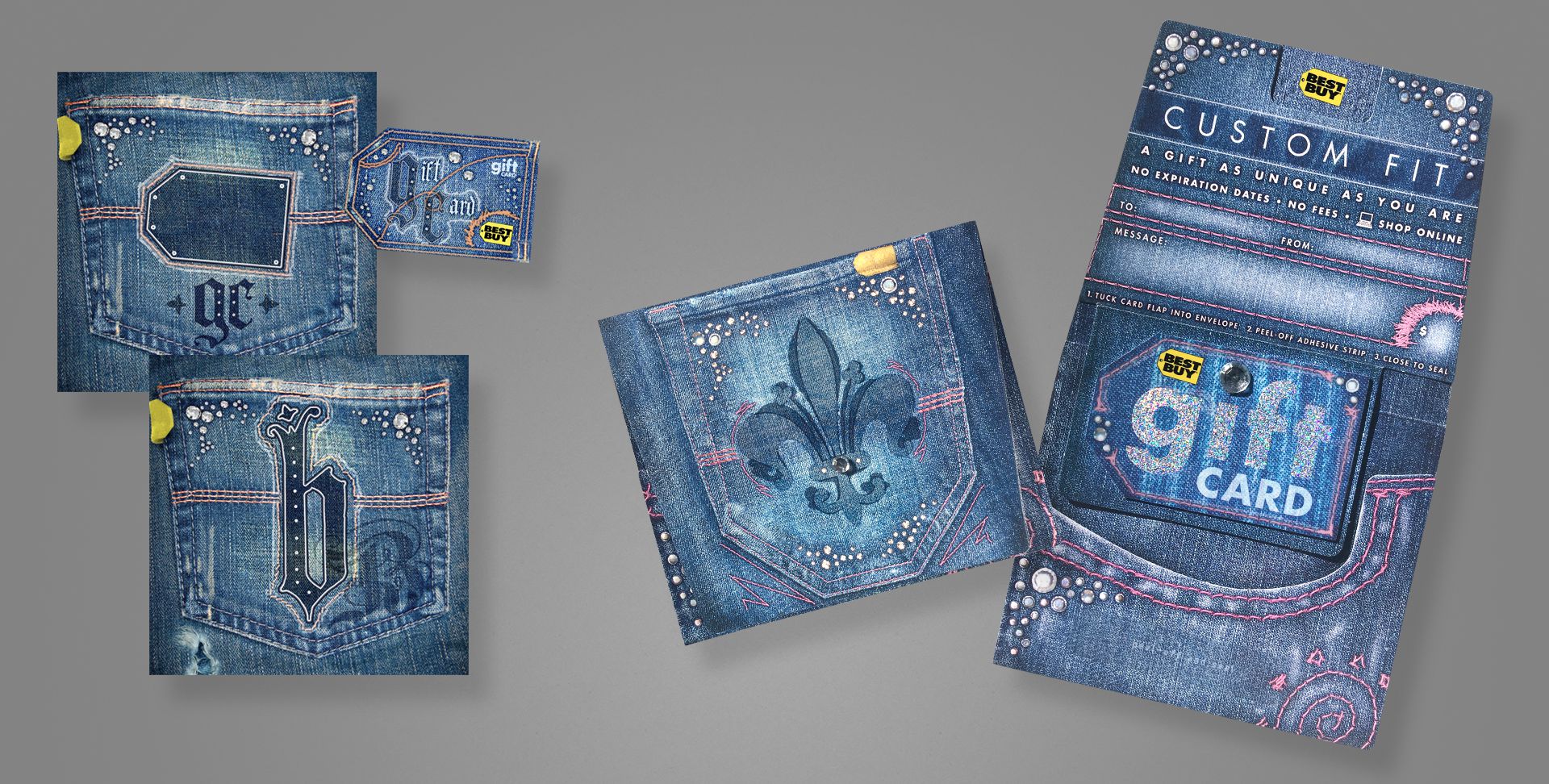
A brand-focused card, we decided to go all out with this one. Embossed, spot UV, spot matte, custom spot foil, and hand-affixed jewels to both the carrier and card. Shown left are two concepts for a gift bag, which eventually became the gift card.
My role spanned from original concept, to photographer, designer, production artist for final mechanicals, and on-press art director.
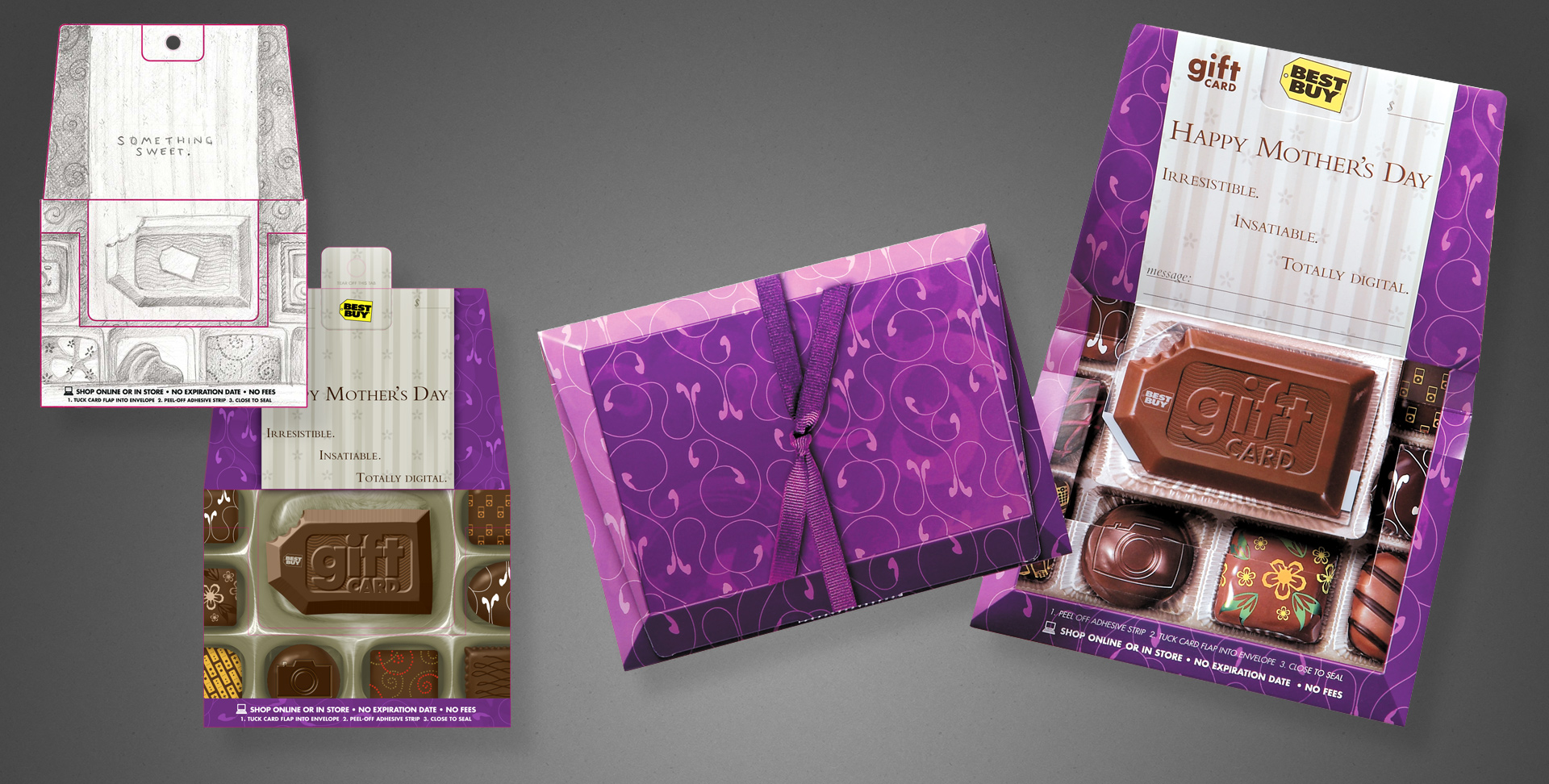
A gift card, available in Spring 2007. The brief was targeted at higher-middle income mothers, or at least as gifts for said demographic. We were to illicit a bit of “boutique”, plus a sense of abundance/selection. So I came up with a box of brand-specific chocolates. When closed, it looks like a box of chocolates, replete with a ribbon. When opened, you see the assortment of sweets.
Shown left are my original illustration and a digital comp. Shown right are my original concept sketch, my rough digital draft, and photography of the final product to show my workflow and vision carried out between media. I was responsible for the concept, client presentation, art direction and supervision of an illustrator hired for the final image, and the press check.

After having a Mother’s Day card aimed at a more sophisticated, upscale demographic, we of course needed one to match the fathers in the same category as well.
Shown left are my original pencil concept, and my first rough digital comp. An additional, unused tackle box concept is also shown. Finally, photography of the finished, printed illustration, open and closed. The closed design mimics a fine leather wallet, and the card design used a layered process with metallic inks to give depth and some visual flash.
Pencils and digital comps are my direct work; I art directed the final illustration via a sourced illustrator, and oversaw the printing process/press check.

A brand card that aimed at a more sophisticated, tech-savvy or early-adopter demographic. This project used a silver ink with 1C overprint for the textured metal effect on the carrier, and a layered card that shows different elements on the fronts and backs of each plastic layer, to give a parallax, 3D depth effect.
My original concept is on the left, and photography of the final printed card/carrier on the right. I art directed an illustrator for the final, prepared mechanical files as the project production artist, and oversaw the printing process/press check.
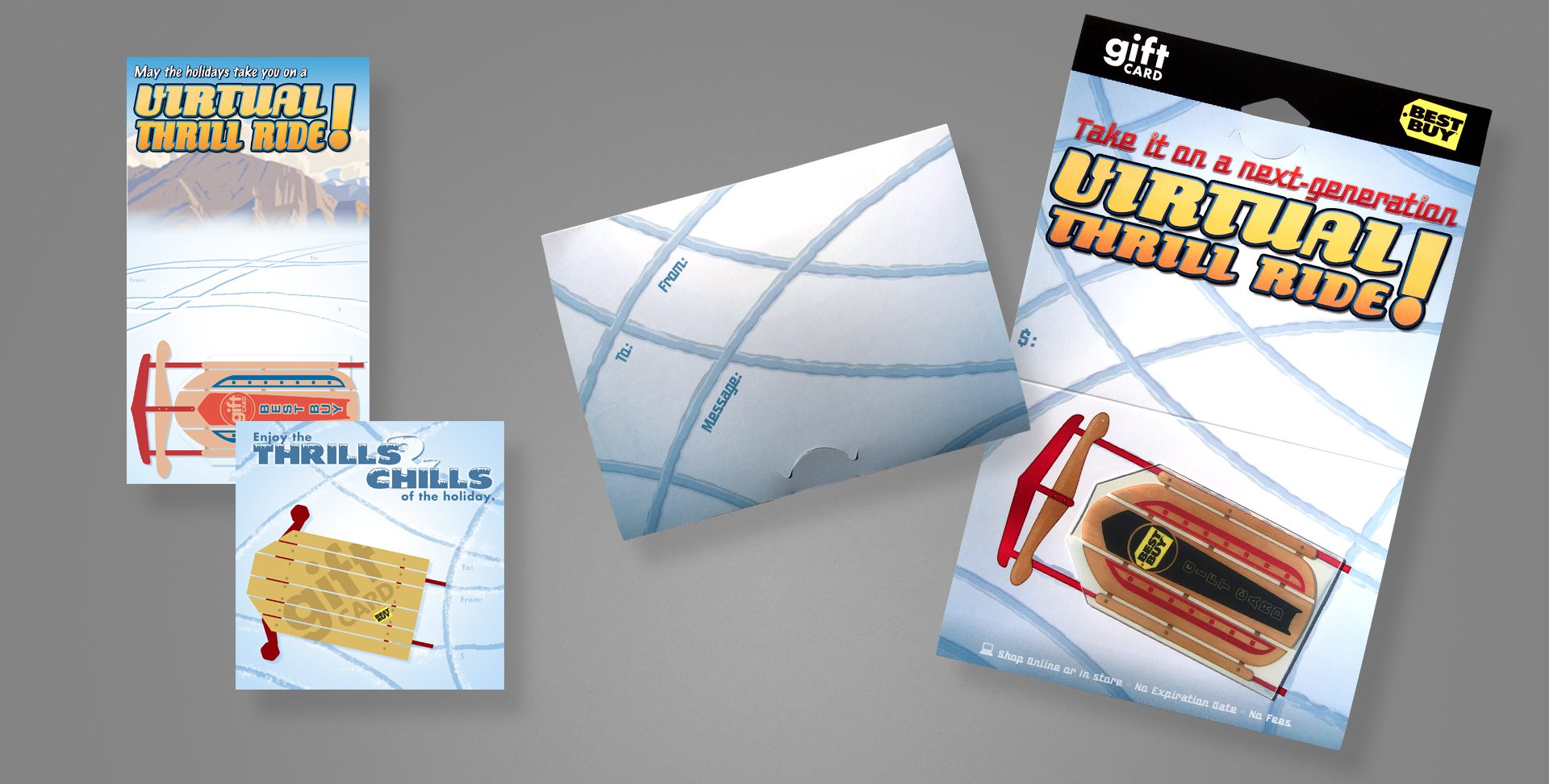
A holiday card that plays off the shape of the Best Buy tag. This card uses a clear card technology, so surrounding the sled body and between its wooden slots are completely clear.
My original concepts are on the left; photography of the final card and carrier are on the right.
I served as the designer from concept to the final design, with the exception of art directing an external illustrator, who produced the woodgrain and metallic elements of the sled; as well as assisted on production art of the mechanical files and attended all press checks.
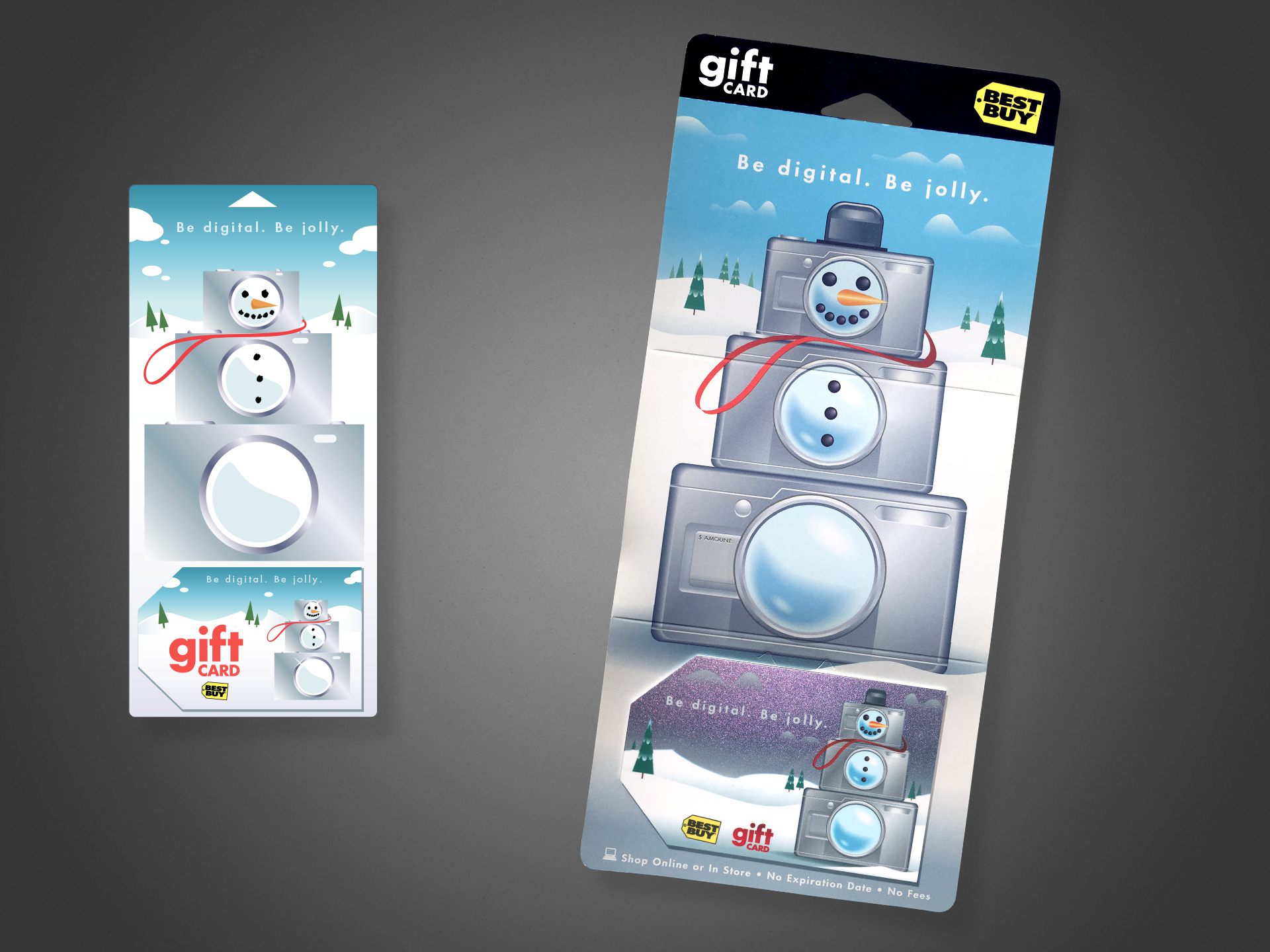
This holiday card is, conceptually, one of my favorites, simply due to it’s light-hearted, whimsical take on the Best Buy brand and its “abundance” component. This project features a color-shifting metallic fleck on the card, shifting between blue, teal, and the purple tones visible above.
Shown left is my original digital concept; shown right is photography of the final product. I served as the designer from concept, to art directing an external illustrator for the final illustration. I assisted with production art of the mechanical files, and attended press checks.
Cutting Room Floor
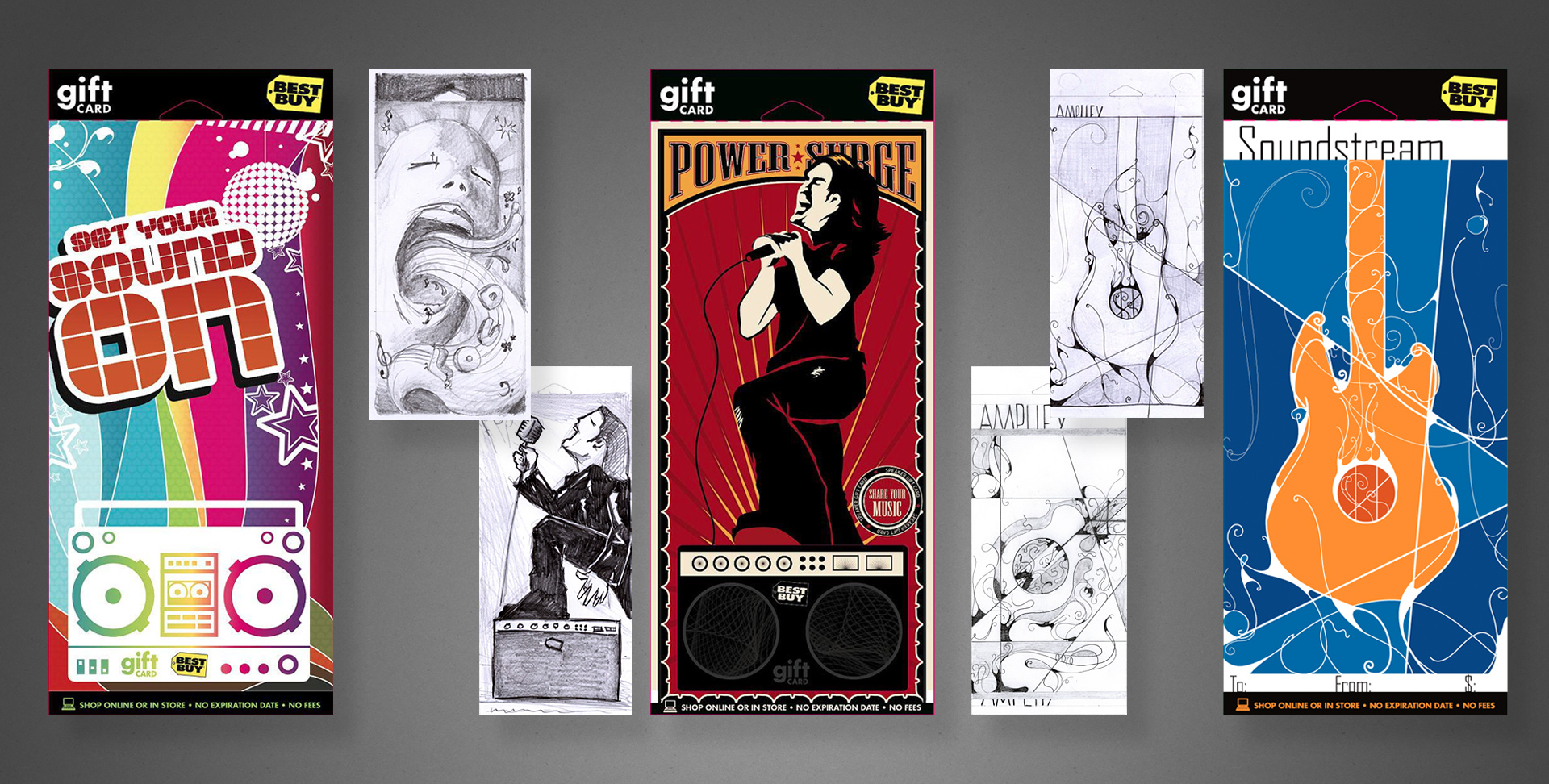
As gift cards became more popular in the mid ’00s, ways of standing out amid the massive selection became more important for the business end. That included exploring new substrates (plastic, clear, metal, etc.), new inks (metallic, color-changing, textured, etc.), and new form factors.
One of the alternate form factors our group explored was a gift card that doubled as a standalone speaker–requiring only an external audio source be plugged in via a standard headphone-style jack. Yes, it was thicker than a standard card, making swiping a magnetic strip impossible, and yes, the speaker was tiny and didn’t sound like much, but it was certainly on-brand as electronics and entertainment go, and something new to the gift card arena.
Included are a number of my pencil concept sketches, plus a number of digital comps.
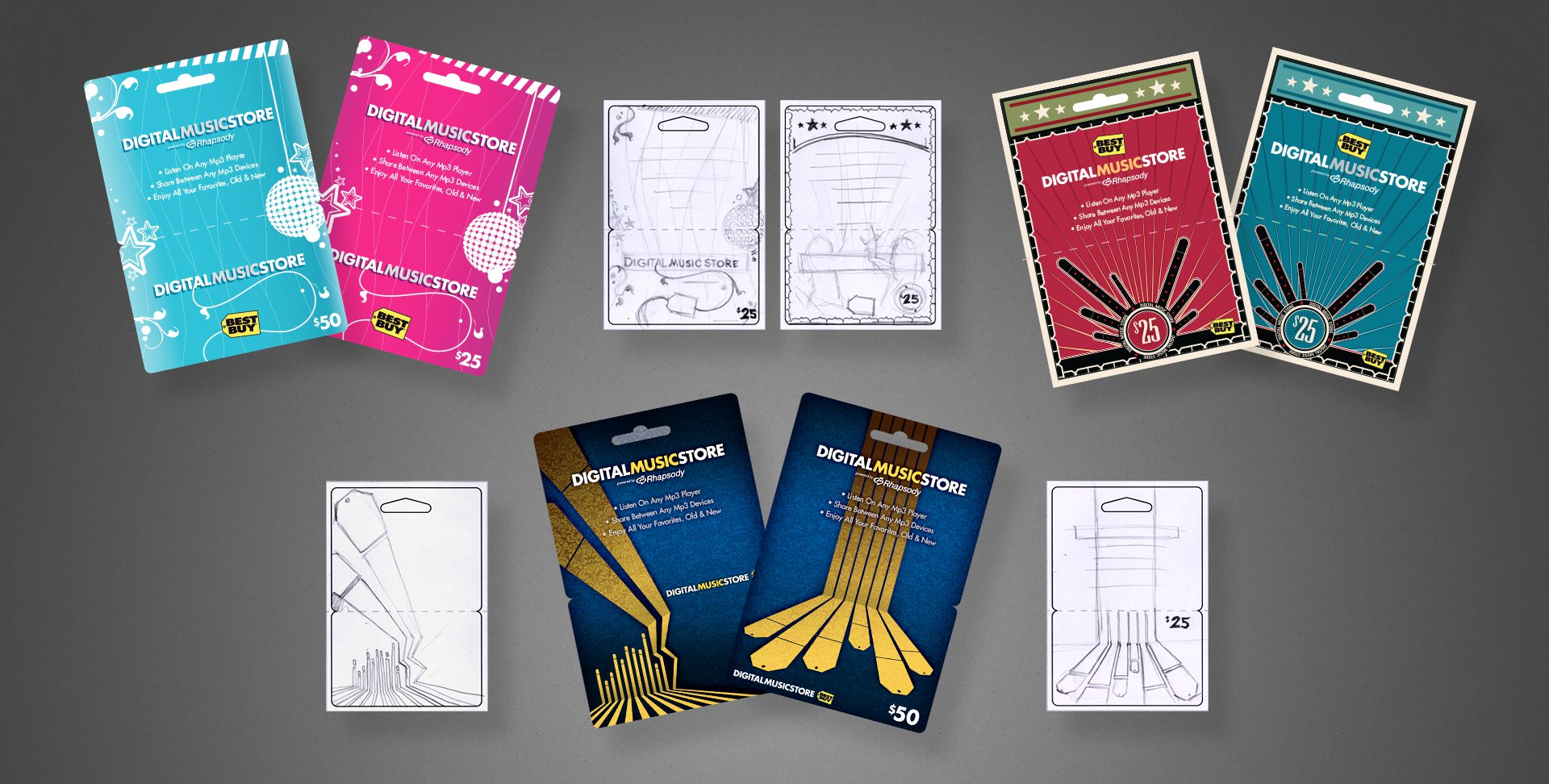
Above are a variety of concepts to be used for an online music service, each accompanied by my original sketch to illustrate my typical work flow. The dark blue cards in the lower-center were ultimately chosen for production, along with a third design in the series not pictured here.
Less formally presented but my favourite… the 3-in-1 jewel case card:
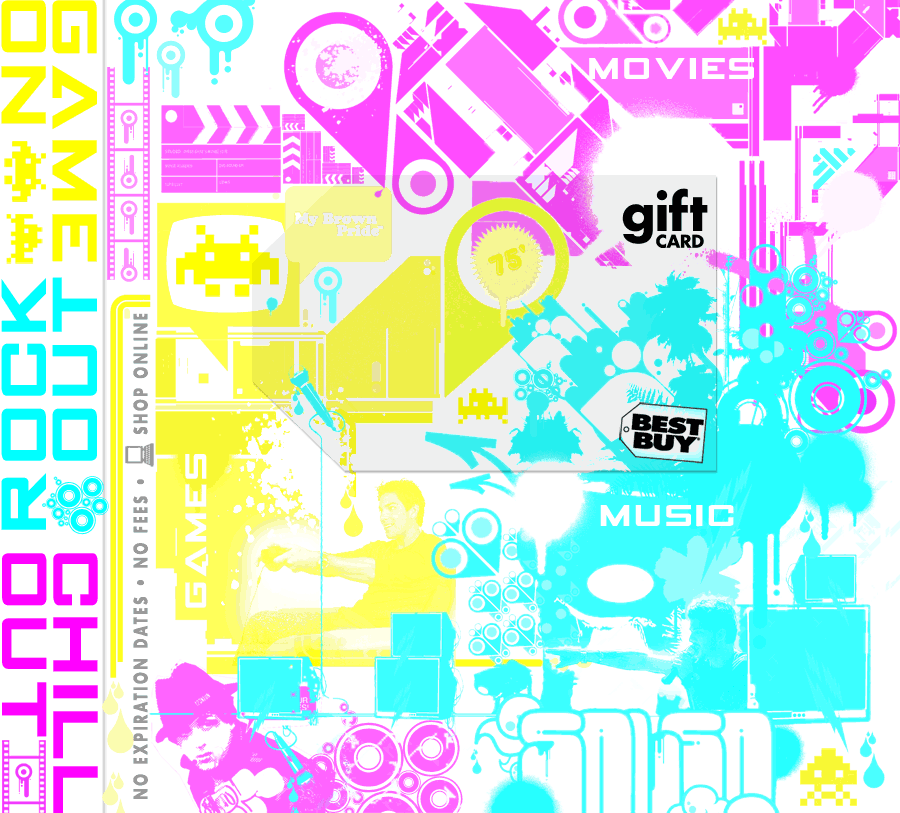

The brief was to design three entertainment gift cards, all to be merchandised amongst the in-store media (music, dvds, games).
To make the most of a limited budget, with some inspired and cunning use of the physical sciences, I devised a single design that would be transformed for each category using a different colour vellum overlay inside the jewel case. By exploiting properties of light, I could effectively hide two ink colours with a single transparent overlay.
B2B Gift Package
Project: B2B holiday gift package
Role: Art Director & Designer, Brand Design & Integration team
Client: Best Buy Co.
Key Skills: Photoshop, Illustrator, InDesign, Brand Design, Product Design
Summary: A premium holiday gift package for B2B customers, complete with a mailable box/packaging, exclusive discount coupons, and signed greeting card.

Every year, Best Buy produces a special holiday greeting card to its business customers (B2B), as a thank you for their patronage. When approached to lead the project one year, I took things a step beyond a simple greeting card, and created more of an actual gift package, one that also matched the company’s holiday campaign, which included gift box iconography and copy.
The box includes an additional flap that folds over the messaging visible on the above image (leftmost two samples), with space for mailing. Once opened, the recipient reads “You shine.”, on a shiny, silver foil box. Sliding out that box reveals a secondary message printed on the inside of the carton, “We thank you.” Inside the box is an actual greeting card, hand-signed by the team and containing a special offer coupon. The elegance and simplicity throughout this piece was really satisfying, and went over remarkably well with recipients.
My role extended from the original concept, where I literally spent the first week working through the form factor, hand-making various mockups to test; to the design and production of the final mechanical files.
Industrial Product Design
Project: Private label product line revision
Role: Art Director & Industrial Designer
Client: Insignia
Key Skills: Photoshop, Illustrator, Brand Identity, Product Design
Summary: A new line of private label products struggled to achieve a cohesive—and upscale—image across its variety of products.
Many consumers immediately associate private label (or as they’re commonly referred to in the pejorative, “generic”) products with similar, but inferior quality, at least compared to brand-name equivalents.
What those same consumers don’t know is that in many cases, the generics are manufactured by the same factories on the same equipment, etc. as their more expensive counterparts. Swapping a mould, logo, or packaging design between them is almost trivial.
The Insignia brand manufactures a heap of private label electronic goods for Best Buy, but early in their journey, they struggled to create a cohesive identity amongst their product lines, because each was produced independently by whichever facility was manufacturing it.

Right: the family resemblance is not only obvious, but its refined elegance suitable for any discerned A/V enthusiasts
No more apparent a case made than that of home theatre products, when they’re often literally stacked together. Insignia A/V offerings were all over the place, literally and figuratively, because each factory did whatever they wanted to satisfy the technical requirements and called it a day.
I was charged with providing branding and industrial design support, both to align the products’ appearances but also elevate their chicness, especially when placed on shelves alongside high-design and higher-priced competition. The scattershot fit and finish simply reflected poorly on both the products and brand.
A peek at one example of product families, we can see on the left the somewhat schizophrenic and mismatched pairing of a receiver and its cohort Blu-ray player.
My recommendation for revisions to both—staying within budget—is shown on the right. All done completely in Photoshop (and with vector shapes/layer styles for resolution independence no less).
These efforts did spark something of a renaissance within Insignia’s product and manufacturing group, evident to this day in their more well-conceived line of goods.
I actually enjoyed this enough that I considered returning to school to get certified/qualified in industrial design. However, in the course of informational interviews with existing professionals, all interestingly shared the same warning: “if you want to do industrial design, just realise that everything you ever do will end up in a landfill someday”.
Ouch. Digital products it shall be then.
